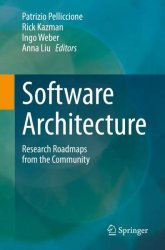 Название: Software Architecture: Research Roadmaps from the Community
Название: Software Architecture: Research Roadmaps from the CommunityАвтор: Patrizio Pelliccione, Rick Kazman, Ingo Weber
Издательство: Springer
Год: 2023
Страниц: 116
Язык: английский
Формат: pdf (true), epub, mobi
Размер: 10.1 MB
Software architecture research involves the study of the design and analysis of software systems, focusing on the high-level structure and organization of software components, as well as the interactions and relationships between them. It also focuses on the non-technical aspects of software design: how teams are organized, and how they communicate and work together.
The first three chapters of the book investigate software architecture for emerging classes of software systems with widespread interest, including quantum computing, artificial intelligence-centric systems, and systems within value-based ecosystems. Subsequent chapters investigate the role of architecture in relation to modern development processes; sharing of data as an enabler for furthering research in software architecture; and teaching software architecture.
In summary, this book provides an overview of the latest research and directions in software architecture, covering a wide array of current and emerging topics. Specifically, this book is a valuable resource for researchers and students to aid them in identifying fruitful paths for future research.
In the following, we provide an overview of the chapters. Chapter 1 “Challenges and Opportunities in Quantum Software Architecture,” provides an overview of the issues related to designing software architectures for quantum computing systems. With the advent of quantum computing, software architects face new challenges in designing software architectures that can leverage the power of quantum computing. This chapter provides an overview of the current state of the art in quantum software architecture research and discusses future research opportunities in this emerging field. Chapter 2 “Data-Intensive Software Systems: To AI and Beyond,” presents a roadmap for data-intensive and AI-based software system architectures. The authors identify, classify, and reflect on the main challenges for the development of these systems, focused on data collection, analysis, and post-processing. The roadmap summarizes the main research challenges identified, including metadata and model management, model deployment architectures and scalability, and observability and adaptability. Chapter 3 “Architecting and Engineering Value-Based Ecosystems,” presents a future where people, systems, machines, and other entities form a dynamic and highly unpredictable ecosystem.
Chapter 4 “Continuous Alignment Between Software Architecture Design and Development in CI/CD Pipelines,” presents the importance of maintaining continuous alignment between software architecture design and the development process, for the purpose of clarity and ease of maintenance of the system, as well as the ability to detect architectural decay. Chapter 5 “An Empirical Basis for Architecture Research,” discusses the motivation for having a repository of curated, standardized, clean, well-maintained, documented, easily accessible, reusable, and shared datasets to catalyze broader and more ambitious programs of empirical studies in software architecture research. Chapter 6 “A Better Way to Teach Software Architecture,” first describes how software architecture education is not regularly taught in university curricula, and when it is taught, it is typically only through the heroic efforts of individual educators. Because there is a lack of good teaching material, software architecture is seldom taught, and because it is seldom taught, there is little push for better materials. This chapter aims to establish a base guideline for what software architecture topics need to be taught, both technical and non-technical topics, and suggests appropriate teaching methods to best prepare students to be software architects in practice.
Скачать Software Architecture: Research Roadmaps from the Community